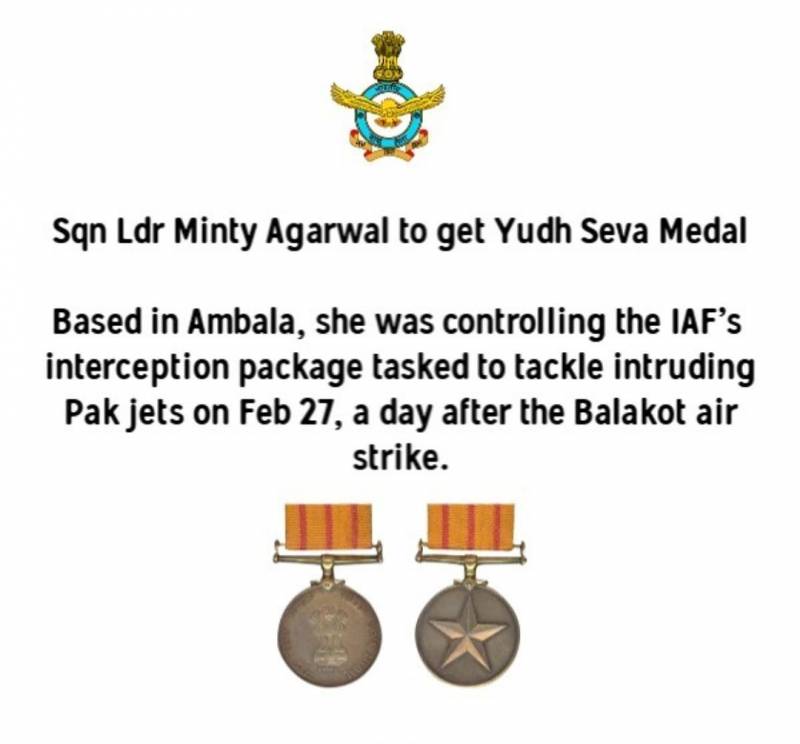Balakot strike highlights the role of a fighter controller
By TJ Reddy
Indian Air force squadron leader Minty Agarwal, the fighter controller on ground radar who helped wing commander Abhinandan to take down the Pak F-16 from his MIG -21 aircraft has been conferred with the Yudh Seva Medal (YSM) on Independence Day, in recognition of her effort as a fighter controller during the operation.
With a preeminent role to guide fighter pilots, the job of the IAF’s fighter controller is all set to transcend from the realm of ‘control of interceptors and air surveillance’ to that of managing the ‘air battle’ completely. This role was evident in the Balakot strike and in the air operations that followed, that helped make Abhinandan’s mission a success.
The Balakot strikes highlight the role of fighter controllers (air defence controllers) like Minty Agarwal in the offensive and defensive operations by day and night:
A fighter controller is endowed with responsibilities of upholding the air defence operations which involve warranting implementation of all restrictions imposed for flight safety and traffic decongestion, ensuring authorisation of all flights within national airspace, close monitoring of general hostile areas analysing enemy’s activity both during peace and war, initiating tactical action with available weapon system in case of unauthorised activity.
Their job entails a complex set of tasks requiring very high levels of technical knowledge and expertise, as well as practical application of specific skills pertaining to cognition (e.g. spatial perception, information processing, logic reasoning, decision making), communication and human relations.
With the help of ground radar, fighter controllers monitor a number of aircraft at any given time. Additionally, initiation of tactical action in case of violation of air space and surveillance of enemy airspace are exclusively carried out by them. Furthermore, the scope has increased with induction of newer air surveillance systems which function both on ground and in air.
The cliché - man behind the machine, in aviation context, is very significant and diverse today, perhaps more than ever. With the advent of the AWACS (Airborne Warning and Control System) in recent times in aerial-battle management scenarios, this aspect has undergone a paradigm shift with the incorporation of the hitherto unseen catalyst – Fighter Controllers (FC), manning work stations on board the AWACS.
Fighter pilots of yore were often deemed ‘flying aces’ depending upon the number of enemy aircraft that they downed single-handedly or at best, in pairs in the ‘dog-fights’ that ensued. The manifestation of modern day air combats with multitudes of fighter aircraft in an era of ‘beyond-visual range’ (BVR) missiles today are a scenario, far removed from that.
Comprehensive situational awareness is the buzzword for survivability for any modern-day fighter pilot. To achieve that it is mandatory to match the inputs from the AWACS and ground radars to help make the entire airspace transparent. It is here that the fighter controller’s role assumes significance as they play a decisive role in the outcome of aerial battles.
Integration of fighter controllers actively into IAF operations goes back in history where they played a significant role in all our wars. With the advent of all-aspect infrared (IR) missiles and BVRs in the mid-80s, the pilot-controller synergy reached a new level.
This lethal team combination has now become more meaty, with the FC now being available inside the airborne platform.
It is a well recognised and widely acknowledged that in all bilateral international exercises with US, Royal Air Force and French Air Force in the last decade and more IAF fighter controllers matched skills with their more experienced counterparts adapting to the new environment with panache. IAF pilots and FCs made their presence count in every exercise.
Note: The writer himself was a Fighter Controller from 1963 to 1977 during his Air Force service. He was a leading Fighter Controller and participated actively in both 1965 and 1971 wars. He was awarded VSM (Vishist Seva Medal) by the President of India on 26 January 1976: TJ Reddy, VSM